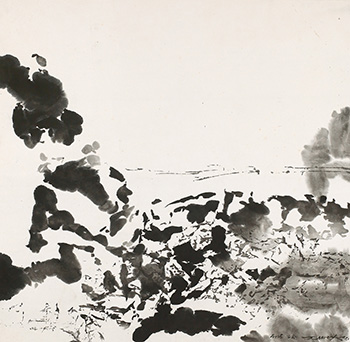Catalogue Note:
In the works of Zao Wou-Ki, the mindsets that alternate during various periods of his career and his experiences of life are quietly but fully revealed upon his canvases and papers. He was also gifted in the creation of spatial dimensions and new universes of delightful unfamiliarity that take his viewers upon a compelling journey and immerse them in the spiritual rhythms of his artistic soul. In 1971, Zao’s beloved wife Chan May-Kan became gravely ill. He was unable to concentrate on his art and could only dabble in ink painting as a means of distraction. Following the grief of his wife’s death in 1972, Zao once again returned to ink painting and created a series of seemingly meaningless and highly repetitive ink works to alleviate his inner suffering. These unintentional creations, however, portray the artist’s rich Chinese cultural heritage and a return to his spirit roots by conveying his artistic vocabulary in its purest, most intrinsic form. Upon his return to Paris from China, Galerie de France organized a joint exhibition featuring Zao Wou-Ki’s ink paintings and the sculptures of his deceased wife Chan May-Kan in November of the same year.
“Among my overall artistic cultivations, I cannot deny the influence of Paris; I must also clarify that my true personality has matured with the re-discovery of Chinese traditions,” Zao had stated (in “Zao Wou-Ki: Autoportrait”, co-authored by Zao Wou-Ki and Francoise Marquet, Artists Editions, 1993). After his beloved wife passed away from illness, he went back to China and brought back with him a large quantity of ink and paper for creating his work. These mediums closest to his cultural roots ultimately transformed into a comforting embrace. The washes of ink in the paintings embodied the pulse of life, while the sweet serenity of the voids in between embalmed and soothed his injured soul.
In “Landscape,” created in 1981, the panoramic composition often adopted by Tang and Song dynasty literati can be clearly seen. This was also precisely the “most beautiful painting style” that Zao had painstakingly sought after while living in France. The brush strokes forming painting have become intangible, carefree, yet still creating a larger, more voluminous space through the coloration of ingeniously placed ink marks. The overall structure is formed by a cascade of strokes as of a rushing waterfall. It bears the muted magnificence of an imposing but distanced landscape but is at the same time an image that evokes a sense of the abstract. Although the artist had abandoned colors, forms and lines in his creation, the singular monotonous tone embodies a hidden strength. The layers of ink in various tones of intensity flow together as effortlessly as a song with none of the complexities found in harmonic choruses. Instead, it relies on powerful, orderly notes that rise and fall in the creation of an exquisitely harmonious melody. Zao attained yet another pinnacle of his artistic career during this time; he had been anxious to leave Chinese culture behind, but the advice of his good friend Henri Michaux caused him to continue working with ink and once again return to the lovely landscapes of traditional Chinese art. This culmination of spiritual wisdom gained after much experience and ceaseless effort became the most harmonious form of his artistic expression.
Note: Gu Mei, real name Gu Jiami, is a singer from Hong Kong who began to practice painting in the late 1960s after retiring from her role as a performer. She studied under Chao Shao-An and Hu Nian-Zu, and has held many ink painting exhibitions.
“Among my overall artistic cultivations, I cannot deny the influence of Paris; I must also clarify that my true personality has matured with the re-discovery of Chinese traditions,” Zao had stated (in “Zao Wou-Ki: Autoportrait”, co-authored by Zao Wou-Ki and Francoise Marquet, Artists Editions, 1993). After his beloved wife passed away from illness, he went back to China and brought back with him a large quantity of ink and paper for creating his work. These mediums closest to his cultural roots ultimately transformed into a comforting embrace. The washes of ink in the paintings embodied the pulse of life, while the sweet serenity of the voids in between embalmed and soothed his injured soul.
In “Landscape,” created in 1981, the panoramic composition often adopted by Tang and Song dynasty literati can be clearly seen. This was also precisely the “most beautiful painting style” that Zao had painstakingly sought after while living in France. The brush strokes forming painting have become intangible, carefree, yet still creating a larger, more voluminous space through the coloration of ingeniously placed ink marks. The overall structure is formed by a cascade of strokes as of a rushing waterfall. It bears the muted magnificence of an imposing but distanced landscape but is at the same time an image that evokes a sense of the abstract. Although the artist had abandoned colors, forms and lines in his creation, the singular monotonous tone embodies a hidden strength. The layers of ink in various tones of intensity flow together as effortlessly as a song with none of the complexities found in harmonic choruses. Instead, it relies on powerful, orderly notes that rise and fall in the creation of an exquisitely harmonious melody. Zao attained yet another pinnacle of his artistic career during this time; he had been anxious to leave Chinese culture behind, but the advice of his good friend Henri Michaux caused him to continue working with ink and once again return to the lovely landscapes of traditional Chinese art. This culmination of spiritual wisdom gained after much experience and ceaseless effort became the most harmonious form of his artistic expression.
Note: Gu Mei, real name Gu Jiami, is a singer from Hong Kong who began to practice painting in the late 1960s after retiring from her role as a performer. She studied under Chao Shao-An and Hu Nian-Zu, and has held many ink painting exhibitions.
